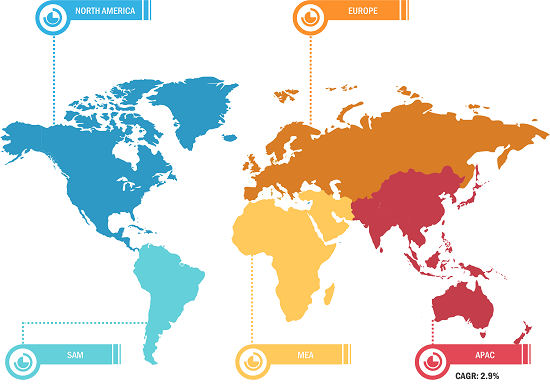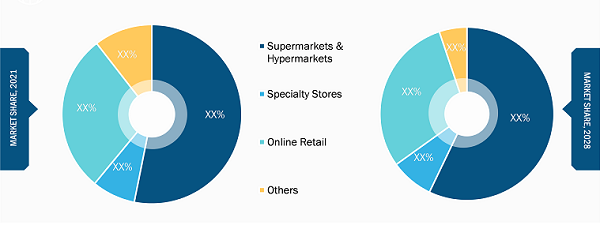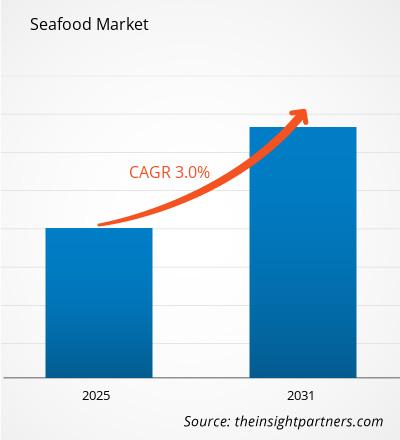海鲜市场预计将从 2022 年的 171,493.93 百万美元增长到 2022 年的 171,493.93 百万美元到2031年将达到20125349万;预计 2022 年至 2031 年复合年增长率为 3.0%。
美国食品和药物管理局 (FDA) 规定,海鲜包括所有商业获得的咸水和淡水鱼、软体动物贝类和甲壳类动物。由于其对健康的益处,预计全球对海鲜的需求将急剧增长。据联合国粮食及农业组织 (FAO) 预测,到 2030 年,需要增加 4000 万吨海产品的附加值,增幅约为 30%,才能满足未来几年不断增长的需求。此外,人均消费量的增长以及富裕国家对进口海鲜产品的需求预计将支持预测期内的市场增长。
亚太地区占据最大份额海鲜市场。日本、中国和韩国等国家的文化中,鱼具有传统意义;因此,这些国家对鱼类的高需求可能会推动海鲜行业的增长。除了新鲜海鲜外,海鲜罐头也深受该地区人民的喜爱。例如,金枪鱼因其诱人的口味和多种口味的融合能力而深受亚洲人的欢迎。金枪鱼罐头产品展现出不同于正在渗透亚太市场的传统产品的独特风味。此外,随着电子商务服务的不断发展,分销系统的增强正在推动海鲜市场的增长。
战略见解
海鲜市场细分 -按地区

市场洞察
对冷冻和罐装海鲜的需求增加
随着加工海鲜的需求不断增加,冷冻和罐装海鲜产品市场在全球范围内迅速增长。冷冻海鲜产品经过冷冻加工,有助于防止食品产生细菌并延长其保质期。同样,鱼罐头也是在铝罐或锡罐等密封容器中加工和保存的。鱼罐头的保质期通常为1-5年。由于对方便食品的需求不断增长,罐头海鲜产品在消费者中获得了巨大的吸引力。同样,冷冻海鲜也受到了消费者的积极欢迎,推动了市场增长。随着新兴技术的引入,冷冻海鲜保留了与新鲜海鲜相似的营养价值和味道。冷冻可以减缓腐烂过程,从而保留其营养价值。捕获后数小时内冷冻的鱼含有保存完好的维生素。人们发现,新鲜的鱼容易快速降解,保质期也较短。因此,对罐装和冷冻海鲜产品的便利性和延长保质期的需求不断增长,加上主要参与者不断增加的研发活动,正在推动全球海鲜市场的增长。
基于产品类型的洞察
< p>根据产品类型,海鲜市场分为鱼类、甲壳类、软体动物等。甲壳类动物预计在预测期内复合年增长率最高。甲壳类动物是甲壳亚门(节肢动物门)的成员,甲壳亚门是一组无脊椎动物,全世界约有 45,000 个物种。甲壳类动物包括一些常见的海鲜,如蟹、虾、龙虾、对虾、小龙虾、磷虾和藤壶。它们有助于减肥,有助于增强免疫力,并促进热量和热量。大脑健康。咖喱蟹和咖喱蟹饺子、龙虾纽堡、盆栽虾、莫埃什、虾浓汤、谷物虾和母蟹汤是一些最著名的甲壳类菜肴,在全球各地都有消费。分销渠道洞察
根据分布,海鲜市场分为超市和大卖场、专卖店、网上零售等。超市和2021年,大卖场细分市场在海鲜市场中占据最大份额。超级市场和大卖场是指提供各种销售产品的自助商店。超市和大卖场设有专门的海鲜专区。因此,为客户提供了多种选择,尤其是冷冻区。超市和大卖场的海鲜柜台被认为是购买各种新鲜和冷冻海鲜的绝佳场所。这些因素预计将推动该细分市场的增长。
海鲜市场,按分销渠道划分 - 2022 年和 2031 年 < /strong>
< /strong>
海鲜市场的一些主要参与者包括 American Seafoods Company LLC、Kangamiut Seafood A/C、Lee Fishing Company、Pacific American Fish Co. Inc、Royal Greenland A/S、Mowi ASA、The Union Group PCL、Grupo Nueva Pescanova、Trident Seafoods Corporation 和 SeaPak Shrimp &海鲜公司。这些参与者致力于开发降低健康风险的产品,以满足新兴的消费趋势并遵守监管框架。他们通过并购、业务扩张和合作来扩大市场份额。
报告焦点
- 海鲜市场的进步行业趋势,帮助参与者制定有效的长期战略
- 采用的业务增长战略确保发达市场和发展中市场的增长
- 2022-2031年海鲜市场定量分析
- 全球海鲜需求估算
- 波特五力分析说明了行业内买家和供应商的效率
- 了解竞争市场情况的最新进展
- 市场趋势和前景,以及控制海鲜市场增长的因素
- 通过强调支持商业利益的市场策略来协助决策过程,从而促进市场增长
- 各节点海鲜市场规模
- 市场及食品饮料行业动态的详细概述和细分
- 具有良好增长机会的各个地区的增长规模
- 历史分析(2 年)、基准年、预测(7 年)及复合年增长率
- PEST 和 SWOT 分析
- 市场规模价值/数量 - 全球、区域、国家
- 行业和竞争格局
- Excel 数据集


- Ketogenic Diet Market
- 3D Mapping and Modelling Market
- Aircraft MRO Market
- Medical Second Opinion Market
- Pipe Relining Market
- Trade Promotion Management Software Market
- Foot Orthotic Insoles Market
- Small Internal Combustion Engine Market
- Emergency Department Information System (EDIS) Market
- Automotive Fabric Market

Report Coverage
Revenue forecast, Company Analysis, Industry landscape, Growth factors, and Trends

Segment Covered
This text is related
to segments covered.

Regional Scope
North America, Europe, Asia Pacific, Middle East & Africa, South & Central America

Country Scope
This text is related
to country scope.
常见问题
The major players operating in the global seafood market are American Seafoods Company LLC, Kangamiut Seafood A/C, Lee Fishing Company, Pacific American Fish Co. Inc., Royal Greenland A/S, Mowi ASA, The Union Group PCL, Grupo Nueva Pescanova, Trident Seafoods Corporation, SeaPak Shrimp & Seafood Company among many others.
In 2019, the Asia Pacific held the largest share of the global seafood market. Asia Pacific is a mature and well-established market for seafood. Countries such as Japan, China, and South Korea have a traditional significance of fish in their cultures, and hence, the high demand for fish in these countries is likely to fuel the growth of the seafood market. In addition to fresh seafood, canned seafood is also highly embraced by the region’s population. For instance, tuna is highly popular among the Asian people attributed to its appealing taste and ability to blend well with multiple flavors. The canned tuna products penetrating the Asian market are exhibiting unique flavors apart from the conventional ones. However, in recent years the canned tuna sales in the region have been declining due to the consumers swaying towards other seafood, particularly shellfish. Thus, the manufacturers have been innovating their products in terms of base ingredients that can attract consumers. However, in Australia, canned tuna sales are escalating.
The growth of the crustaceans type segment is primarily attributed to the fact as many species of crustaceans are found in freshwater, seawater and also in inland brines. The crustaceans group include some commonly consumed seafoods like crab, shrimp, lobsters, prawns, crayfish, krill and barnacles. These crustaceans develop form larvae and bear segmented, split limbs or appendages. The fisheries in many parts of the world capture prawns, shrimps, spiny lobsters and king crabs, especially from the Northern Pacific and its southern counterparts. Many species of true crabs like the blue crab, Dungeness crab and stone crab serves as a valuable source of food. Crustaceans are consumed as seafoods as they are loaded with lean proteins, micronutrients and healthy fats. They aid in weight loss, helps in boosting immunity and promotes heat & brain health.
Trends and growth analysis reports related to Food and Beverages : READ MORE..
The List of Companies - Global Seafood Market
- American Seafoods Company LLC
- Kangamiut Seafood A/C
- Lee Fishing Company
- Pacific American Fish Co. Inc.
- Royal Greenland A/S
- Mowi ASA
- The Union Group PCL
- Grupo Nueva Pescanova
- Trident Seafoods Corporation
- SeaPak Shrimp & Seafood Company
The Insight Partners performs research in 4 major stages: Data Collection & Secondary Research, Primary Research, Data Analysis and Data Triangulation & Final Review.
- Data Collection and Secondary Research:
As a market research and consulting firm operating from a decade, we have published and advised several client across the globe. First step for any study will start with an assessment of currently available data and insights from existing reports. Further, historical and current market information is collected from Investor Presentations, Annual Reports, SEC Filings, etc., and other information related to company’s performance and market positioning are gathered from Paid Databases (Factiva, Hoovers, and Reuters) and various other publications available in public domain.
Several associations trade associates, technical forums, institutes, societies and organization are accessed to gain technical as well as market related insights through their publications such as research papers, blogs and press releases related to the studies are referred to get cues about the market. Further, white papers, journals, magazines, and other news articles published in last 3 years are scrutinized and analyzed to understand the current market trends.
- Primary Research:
The primarily interview analysis comprise of data obtained from industry participants interview and answers to survey questions gathered by in-house primary team.
For primary research, interviews are conducted with industry experts/CEOs/Marketing Managers/VPs/Subject Matter Experts from both demand and supply side to get a 360-degree view of the market. The primary team conducts several interviews based on the complexity of the markets to understand the various market trends and dynamics which makes research more credible and precise.
A typical research interview fulfils the following functions:
- Provides first-hand information on the market size, market trends, growth trends, competitive landscape, and outlook
- Validates and strengthens in-house secondary research findings
- Develops the analysis team’s expertise and market understanding
Primary research involves email interactions and telephone interviews for each market, category, segment, and sub-segment across geographies. The participants who typically take part in such a process include, but are not limited to:
- Industry participants: VPs, business development managers, market intelligence managers and national sales managers
- Outside experts: Valuation experts, research analysts and key opinion leaders specializing in the electronics and semiconductor industry.
Below is the breakup of our primary respondents by company, designation, and region:

Once we receive the confirmation from primary research sources or primary respondents, we finalize the base year market estimation and forecast the data as per the macroeconomic and microeconomic factors assessed during data collection.
- Data Analysis:
Once data is validated through both secondary as well as primary respondents, we finalize the market estimations by hypothesis formulation and factor analysis at regional and country level.
- Macro-Economic Factor Analysis:
We analyse macroeconomic indicators such the gross domestic product (GDP), increase in the demand for goods and services across industries, technological advancement, regional economic growth, governmental policies, the influence of COVID-19, PEST analysis, and other aspects. This analysis aids in setting benchmarks for various nations/regions and approximating market splits. Additionally, the general trend of the aforementioned components aid in determining the market's development possibilities.
- Country Level Data:
Various factors that are especially aligned to the country are taken into account to determine the market size for a certain area and country, including the presence of vendors, such as headquarters and offices, the country's GDP, demand patterns, and industry growth. To comprehend the market dynamics for the nation, a number of growth variables, inhibitors, application areas, and current market trends are researched. The aforementioned elements aid in determining the country's overall market's growth potential.
- Company Profile:
The “Table of Contents” is formulated by listing and analyzing more than 25 - 30 companies operating in the market ecosystem across geographies. However, we profile only 10 companies as a standard practice in our syndicate reports. These 10 companies comprise leading, emerging, and regional players. Nonetheless, our analysis is not restricted to the 10 listed companies, we also analyze other companies present in the market to develop a holistic view and understand the prevailing trends. The “Company Profiles” section in the report covers key facts, business description, products & services, financial information, SWOT analysis, and key developments. The financial information presented is extracted from the annual reports and official documents of the publicly listed companies. Upon collecting the information for the sections of respective companies, we verify them via various primary sources and then compile the data in respective company profiles. The company level information helps us in deriving the base number as well as in forecasting the market size.
- Developing Base Number:
Aggregation of sales statistics (2020-2022) and macro-economic factor, and other secondary and primary research insights are utilized to arrive at base number and related market shares for 2022. The data gaps are identified in this step and relevant market data is analyzed, collected from paid primary interviews or databases. On finalizing the base year market size, forecasts are developed on the basis of macro-economic, industry and market growth factors and company level analysis.
- Data Triangulation and Final Review:
The market findings and base year market size calculations are validated from supply as well as demand side. Demand side validations are based on macro-economic factor analysis and benchmarks for respective regions and countries. In case of supply side validations, revenues of major companies are estimated (in case not available) based on industry benchmark, approximate number of employees, product portfolio, and primary interviews revenues are gathered. Further revenue from target product/service segment is assessed to avoid overshooting of market statistics. In case of heavy deviations between supply and demand side values, all thes steps are repeated to achieve synchronization.
We follow an iterative model, wherein we share our research findings with Subject Matter Experts (SME’s) and Key Opinion Leaders (KOLs) until consensus view of the market is not formulated – this model negates any drastic deviation in the opinions of experts. Only validated and universally acceptable research findings are quoted in our reports.
We have important check points that we use to validate our research findings – which we call – data triangulation, where we validate the information, we generate from secondary sources with primary interviews and then we re-validate with our internal data bases and Subject matter experts. This comprehensive model enables us to deliver high quality, reliable data in shortest possible time.

 获取此报告的免费样本
获取此报告的免费样本